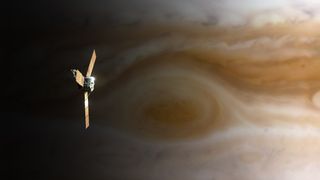
Could a spaceship fly through a gas giant like Jupiter?
After all, Jupiter doesn't have a solid core.

NASA has plunged three spacecraft into gas giants. Two of them, Galileo and Cassini, were at the ends of their missions when they met their doom in the atmospheres of Jupiter and Saturn, respectively. But the Galileo spacecraft arrived with a passenger — a probe designed to drop into a gas giant atmosphere.
NASA lost contact with the Galileo probe after about an hour, when it had reached 93 miles (150 kilometers) into Jupiter's atmosphere. Scientists aren't sure how deep the probe got before it was destroyed by Jupiter's high pressures and temperatures. But could we one day send a spacecraft deeper into a gas giant such as Jupiter or Saturn? Given that these enormous planets may not have a solid surface on which to crash, could a spacecraft fly through a gas giant?
According to Leigh Fletcher, an associate professor of planetary science at the University of Leicester in the United Kingdom, the short answer is "no." A spacecraft could not survive a trip through a gas giant.
Related: How much would you weigh on other planets?
The problem with trying to fly through a gas giant is that "the density, pressure and temperature all increase to such enormous levels as you penetrate down into the interior," Fletcher told Live Science. Near the center of Jupiter, the normally gaseous hydrogen becomes a liquid metal, making this region "as exotic as the surface of the sun," he continued.
To give a sense of the pressure near the center of Jupiter, consider the Mariana Trench on Earth, the deepest place in our oceans. At nearly 7 miles (11 km) deep, pressures reach just over 1,000 bars (100,000 kilopascals), which would feel like 8 tons of pressure per square inch (123,500 kilopascals). At sea level, you experience about 1 bar of pressure (100 kilopascals). Near the center of Jupiter, pressures jump to megabars, or one million bars, Fletcher said. On top of those enormous pressures, temperatures also rise into the tens of thousands of Kelvins, which is equivalent to tens of thousands of degrees Celsius.
At that point, any spacecraft wouldn't be just squished or melted — it would entirely disintegrate into its constituent atoms, Fletcher said.
Sign up for the Live Science daily newsletter now
Get the world’s most fascinating discoveries delivered straight to your inbox.
Here's what a spacecraft might encounter on its journey to the center of Jupiter.
First, the ideal gas giant probe would have to be shaped like a bullet, to improve aerodynamics and allow it to plummet as far down as possible, Fletcher said. As the spacecraft started its descent, it would encounter wispy ammonia clouds and potentially pass through blue skies, due to the same phenomenon of light scattering that occurs in Earth's atmosphere.
After passing through the "gunky, reddy brown" clouds of ammonium hydrosulfide, the spacecraft would reach about 50 miles (80 km) deep, an area of "towering" cumulonimbus clouds, possibly lit up by massive lightning storms, Fletcher said.
Much deeper than that, between 4,350 to 8,700 miles (7,000 to 14,000 kilometers), the spacecraft would encounter an atmosphere so hot that the atmosphere itself would glow, Fletcher said. This is where temperatures rise to tens of thousands of degrees Celsius and the pressure rises to megabars. And this is where the spacecraft starts to disintegrate.
In this still-mysterious region of Jupiter’s interior, hydrogen and helium become a fluid. From the Juno mission, which launched in 2011, scientists have figured out that Jupiter doesn't have a solid core but rather a diffuse core of materials including nitrogen, carbon and even iron. By the time you get to this "fuzzy, mixed" core, "you're no more," Fletcher said.
But Fletcher likes to be poetic about these things. Yes, Galileo, its probe, Cassini and our hypothetical bullet-shaped spacecraft all did disintegrate into their constituent atoms as they plunged into their respective gas giants, but those atoms "will forever be a part of those giant planets. Nothing you put in is ever truly lost from a giant planet."
Editor's note: This story was updated at 12:15 p.m. EDT on Sept. 2 to fix a conversion to kilopascals.
Originally published on Live Science.

JoAnna Wendel is a freelance science writer living in Portland, Oregon. She mainly covers Earth and planetary science but also loves the ocean, invertebrates, lichen and moss. JoAnna's work has appeared in Eos, Smithsonian Magazine, Knowable Magazine, Popular Science and more. JoAnna is also a science cartoonist and has published comics with Gizmodo, NASA, Science News for Students and more. She graduated from the University of Oregon with a degree in general sciences because she couldn't decide on her favorite area of science. In her spare time, JoAnna likes to hike, read, paint, do crossword puzzles and hang out with her cat, Pancake.
